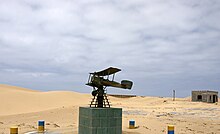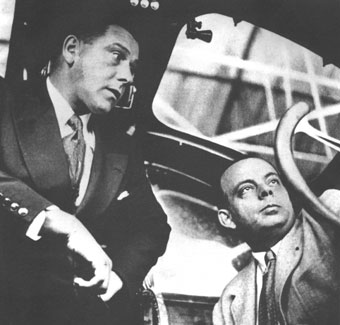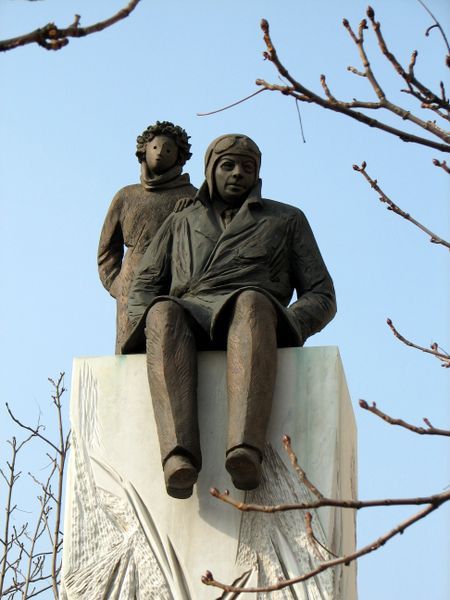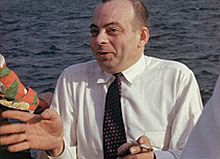มหากฎบัตร (Magna Carta) จากภาษาละตินแปลว่า "กฎบัตรใหญ่"(Great Charter) บางครั้งก็เรียกว่า "กฎบัตรใหญ่แห่งอิสรภาพ" (Magna Carta Libertatum) เป็นกฎบัตรของอังกฤษที่ตราขึ้นเมื่อ พ.ศ. 1758 (ค.ศ. 1215) โดยถือกันว่ามหากฎบัตรนี้คืออิทธิพลที่ยิ่งใหญ่ที่มีต่อประวัติศาสตร์ศาสตร์อันยาวนานของกระบวนการที่นำมาสู่กฎหมายรัฐธรรมนูญในปัจจุบันการที่ มหากฎบัตรเกิดขึ้นมาได้นั้น เนื่องมาจากข้อขัดแย้งระหว่างพระสันตปาปา พระเจ้าจอห์นและคณะขุนนางอังกฤษของพระองค์เกี่ยวกับสิทธิ์ของพระมหากษัตริย์ มหากฎบัตรบังคับให้พระมหากษัตริย์ทรงสละสิทธิ์บางอย่าง และยอมรับกระบวนการทางกฎหมายบางอย่าง และยังให้รับว่าพินัยกรรมของพระมหากษัตริย์ต้องอยู่ภายใต้กฎหมาย
มีความเข้าใจผิดที่แพร่หลายหลายประการเกี่ยวกับมหากฎบัตรนี้ เช่นว่าเป็นเอกสารชิ้นแรกสุดที่จำกัดสิทธิ์ของพระมหากษัตริย์โดยกฎหมายบ้าง (ความจริงไม่ใช่กฎบัตรแรกที่จำกัดสิทธิ์กษัตริย์และมหากฎบัตรนี้ส่วนหนึ่งมาจากสืบเนื่องกฎบัตรแห่งอิสรภาพ) และในแง่ปฏิบัติ พระมหากษัตริย์ถูกจำกัดสิทธิ์บ้าง เป็นเอกสารที่ตายตัวไม่มีการเปลี่ยนแปลงบ้าง
มหากฎบัตรถูกปรับปรุงแก้ไขมาโดยตลอดยุคมืด และแก้ไขต่อในสมัยราชวงศ์ทิวดอร์และราชวงศ์สจวต และต่อมาในสมัยคริสต์ศตวรรษที่ 17 และ 18 (พ.ศ. 2144-2343) ล่วงมาถึงช่วงแรกของคริสต์ศตวรรษที่ 19 มาตราต่างๆ ที่มีเดิมในกฎหมายอังกฤษถูกยกเลิกหรือปรับปรุงไปเกือบหมด
อิทธิพลของมหากฎบัตรนอกประเทศอังกฤษอาจเห็นได้ในรัฐธรรมนูญของสหรัฐอเมริกาและในกฎหมายว่าด้วยสิทธิ์ นอกจากนี้ ประเทศต่างๆ ที่ใช้กฎหมายจารีตแต่มีรัฐธรรมนูญจะมีอิทธิพลของมหากฎบัตรอยู่ ทำให้มหากฎบัตรกลายเป็นเอกสารทางกฎหมายที่มีความสำคัญที่สุดในประวัติศาสตร์แห่งประชาธิปไตย
เนื้อหาหลักในมหากฏบัตร กล่าวถึง สิทธิในการได้รับความคุ้มครองตามกฎหมายของเสรีชน ไม่ว่าบุคคลนั้นจะอยู่ในชนชั้นหรือวรรณะใดก็ตาม และพระเจ้าแผ่นดินจะต้องมอบสิทธินี้ให้กับขุนนางหรือผู้ครอบครองที่ดิน (Vassal) และขุนนางนั้นจะต้องมอบสิทธิให้กับพลเมืองหรือไพร่ในสังกัด โดยพลเมืองทุกคนจะไม่ถูกกดขี่ พ่อค้าและชาวนาไม่จำเป็นต้องมอบสินค้าบางส่วนหรือผลิตผลทางเกษตรให้กับขุนนางหรือพระเจ้าแผ่น เพื่อเป็นค่าคุ้มครอง ดังเนื้อความในส่วนหนึ่งของมหากฏบัตร ที่กล่าวว่า "จะไม่มีบุคคลที่ถูกกักขัง หน่วงเหนี่ยว โดยปราศจากอิสรภาพ หรือถูกยึด ขู่กรรโชก ทรัพย์สินโดยปราศจากคำตัดสินของศาล" นอกจากนี้มีในมหากฏบัตรยังได้กล่าวถึงการเรียกเก็บภาษีของพระเจ้าแผ่นดิน ซึ่งพระเจ้าแผ่นดินจะทรงเรียกเก็บภาษีตามพระราชหฤทัย โดยไม่ผ่านการเห็นชอบจากสภาบริหารราชการแผ่นดิน (The Great Council of the Nation) มิได้
วันจันทร์, กันยายน 26, 2554
วันอาทิตย์, กันยายน 18, 2554
อองตวน เดอ แซง-เตกซูเปรี คุณเคยรู้จักเจ้าชายน้อยไหม
ที่บ้านของฉันมีหนังสือเรื่องเจ้าชายน้อย ฉันเคยหยิบมันขึ้นมาอ่าน แต่ฉันก็ยังอ่านมันไม่จบซักที อาจเป็นเพราะชื่อหนังสือดูเรียบง่ายเกินไป หรืออาจเป็นเพราะเมื่อเปิดอ่านแล้วฉันไม่เข้าใจ ไม่ซาบซึ้งไปกับตัวหนังสือที่ผู้ประพันธ์ได้ตั้งใจประพันธ์กันแน่ หรืออาจเป็นเพราะเนื้อหาในเรื่องต้องใช้การวิเคราะห์มากเกินกว่าที่สมองของฉันจะทำได้กันแน่
Antoine de Saint-Exupéry (French pronunciation: [ɑ̃twan də sɛ̃tɛɡzypeˈʁi]), officially Antoine Marie Jean-Baptiste Roger de Saint Exupéry (29 June 1900 – 31 July 1944, Mort pour la France[ ), was a French writer, poet and pioneering aviator. He is best remembered for his novella The Little Prince (Le Petit Prince) and for his lyrical aviation writings, including Night Flight and Wind, Sand and Stars.
He was a successful commercial pilot before World War II. He joined the Armée de l'Air (French Air Force) at the outbreak of war, flying reconnaissance missions until the armistice with Germany. Following a spell of writing in the United States he joined the Free French Forces. He disappeared on a reconnaissance flight over the Mediterranean and France in July 1944 and is believed to have died at that time.
His literary works, among them The Little Prince—translated into over 190 languages—propelled his stature posthumously after the war allowing him to achieve national hero status in France. He also earned further widespread recognition with international translations of his other works. His 1939 memoir, Terre des Hommes, was used to create the central theme (Terre des Hommes–Man and His World) of the 1967 international exposition in Montreal, Canada, Expo 67, the most successful world's fair of the 20th century.
Early years
Saint-Exupéry was born in Lyon to an old family of provincial nobility, the third of five children of Marie de Fonscolombe and of Viscount Jean de Saint Exupéry, an insurance broker who died before his son's fourth birthday. His father's death would greatly impact the entire family, changing Saint-Exupéry's status to that of an "impoverished aristocrat".
After failing his final exams at preparatory school, Saint-Exupéry entered the École des Beaux-Arts to study architecture. In 1921, he began his military service with the 2e Régiment de chasseurs à cheval (2nd Regiment of Light Cavalry), and was sent to Strasbourg for training as a pilot. The following year, he obtained his license and was offered a transfer to the air force. Bowing to the objections of the family of his fiancée—the future novelist Louise Lévêque de Vilmorin—he instead settled in Paris and took an office job. The couple ultimately broke off the engagement however, and he worked at several jobs over the next few years without success.
By 1926, Saint-Exupéry was flying again. He became one of the pioneers of international postal flight, in the days when aircraft had few instruments. Later he complained that those who flew the more advanced aircraft had become more like accountants than pilots. He worked for Aéropostale between Toulouse and Dakar, and became the airline stopover manager for the Cape Juby airfield in the Spanish zone of South Morocco, inside the Sahara desert. In 1929, Saint-Exupéry moved to Argentina, where he was appointed director of the Aeroposta Argentina airline. This period of his life is briefly explored in Wings of Courage, an IMAX film by French director Jean-Jacques Annaud.
Writing career
Saint-Exupéry's first novella, "L'Aviateur" ("The Aviator"), was published in the magazine Le Navire d'Argent. In 1929, he published his first book, Courrier sud (Southern Mail); his career as aviator was also burgeoning, and that same year he flew the Casablanca/Dakar route.
In 1931, Vol de nuit (Night Flight) —the first of his major works and winner of the prix Femina—was published and established him as a rising star in the literary world. It covers his experiences with Aéropostale. That same year, at Grasse, Saint-Exupéry married Consuelo Suncin (née Suncín Sandoval), a widowed Salvadoran writer and artist. It would be a stormy union, as Saint-Exupéry traveled frequently and indulged in numerous affairs, most notably with the Frenchwoman Hélène (Nelly) de Vogüé. De Vogüé became Saint-Exupéry's literary executrix after his death, and also wrote a Saint-Exupéry biography under the pseudonym Pierre Chevrier.
Desert crash 
Saint-Exupéry monument in Tarfaya (Cabo Juby), the location of an Aéropostale stopover, and adjacent to a museum dedicated to him.
On 30 December 1935, at 14:45, after a flight of 19 hours and 38 minutes, Saint-Exupéry, en route to Saigon with his navigator, André Prévot, crashed in the Libyan Sahara desert. The plane was a Caudron C-630 Simoun n°7042 (registration F-ANRY). The crash site may have been the Wadi Natrun. The team was attempting to fly from Paris to Saigon faster than any previous aviators, for a prize of 150,000 francs. Both survived the crash landing, but were faced with the prospect of rapid dehydration in the Sahara. They had no idea of their location.
According to his memoir, Wind, Sand and Stars, their sole supplies were grapes, two oranges, and a small ration of wine. According to biographer, Stacy Schiff, what Saint-Exupéry himself told the press shortly after rescue was that the men only had "a thermos of sweet coffee, chocolate, and a handful of crackers".They experienced visual and auditory hallucinations; by the third day, they were so dehydrated that they ceased to sweat. Finally, on the fourth day, a Bedouin on a camel discovered them and saved their lives. Saint-Exupéry's fable The Little Prince, which begins with a pilot being marooned in the desert, is in part a reference to this experience.
American and Canadian sojourn and The Little Prince
Two illustrated editions of The Little Prince (lower left and upper right) on display at the Air and Space Museum of France exhibit dedicated to Saint-Exupéry.
Saint-Exupéry continued to write until the spring of 1943, when he left the United States with American troops bound for North Africa in World War II. During the war, he initially flew a Bloch MB.170 with the GR II/33 reconnaissance squadron of the Armée de l'Air. After France's 1940 armistice with Germany, he fled to North America.
Between January 1941 and April 1943 the Saint-Exupérys lived in a penthouse apartment on Central Park South as well as the The Bevin House mansion in Asharoken on Long Island, NY. It was after his arrival in the United States that the author adopted the hyphen within his surname, as he was annoyed with Americans addressing him as "Mr. Exupéry"
The couple also resided in Quebec City, Canada for several weeks during 1942, during which time they met a precocious eight year old boy with blond curly hair, the son of the De Konincks, the family the Saint-Exupéry's resided with. He resumed flying as a WWII reconnaissance pilot in 1943.
Saint-Exupéry wrote and illustrated The Little Prince in New York City and Asharoken in mid-to-late 1942, with the manuscript being completed in October.
Disappearance
The nose landing gear of Saint-Exupéry's P-38 Lightning, recovered from the Mediterranean off the coast of France, displayed at the Air and Space Museum of France.
Following his nearly 25 months in North America, Saint-Exupéry returned to Europe to fly with the Free French Forces and fight with the Allies in a Mediterranean-based squadron. Then 43 with the rank of Major, he was far older than most men tasked to combat status. He also suffered pain and immobility due to his many previous crash injuries, to the extent that he could not dress himself in his own flight suit.
He was assigned with a number of other pilots to P-38 Lightnings, which an officer described as "war-weary, non-airworthy craft." After wrecking a P-38 through engine failure on his second mission, he was grounded for eight months, but was then reinstated to flight duty on the personal intervention of General Ira Eaker, Deputy Commander of the U.S. Army Air Forces. However after the collaborationist Vichy Regime unilaterally promoted Saint-Exupéry as one of its members (coming as a shock to Saint-Exupéry himself), French General (later, President) Charles de Gaulle implied publicly that Saint-Exupéry was supporting Germany. Depressed at this, the pilot began to drink heavily. Additionally, his health, both physically and mentally, had been deteriorating. Saint-Exupéry was said to be intermittently subject to depression and there had been talk of taking him off flying status.
Saint-Exupéry's final assignment was to collect intelligence on German troop movements in and around the Rhone Valley preceding the Allied invasion of southern France ("Operation Dragoon"). Although he had been reinstated to his old squadron with the provision that he was to fly only five missions, on 31 July 1944, he took off in an unarmed P-38 on his eighth reconnaissance mission from an airbase on Corsica. To the great alarm of the squadron compatriots who revered him, he did not return, dramatically vanishing without a trace. Word of his disappearance shortly spread across the literary world and then into international headlines.
A French woman reported much later having watched a plane crash around noon near the Bay of Carqueiranne off Toulon. An unidentifiable body wearing French colors was found several days after his disappearance, east of the Frioul archipelago south of Marseille, and buried in Carqueiranne in September.
Discovery at sea
Bracelet of Saint-Exupéry found in 1998.
In 1998 Jean-Claude Bianco, a fisherman, found, east of Riou Island, south of Marseille, a silver identity bracelet (gourmette) bearing the names of Saint-Exupéry and of his wife Consuelo and his publishers, Reynal & Hitchcock, hooked to a piece of fabric, presumably from his flight suit.
In 2000 Luc Vanrell, a diver, found the partial remains of a P-38 Lightning on the seabed off the coast of Marseille, near where the bracelet was found. The remnants of the aircraft were recovered in October 2003. On 7 April 2004, investigators from the French Underwater Archaeological Department confirmed that the plane was, indeed, Saint-Exupéry's F-5B reconnaissance variant. No marks or holes attributable to gunfire were found; however, that was not considered significant as only a small portion of the aircraft was recovered. In June 2004, the fragments were given to the Air and Space Museum in Le Bourget, Paris, where Saint-Exupéry's life is commemorated in a special exhibit.
The location of the crash site and the bracelet are less than 80 km by sea from where the unidentified French soldier was found in Carqueiranne, and it remains plausible, but has not been confirmed, that the body was carried there by sea currents after the crash over the course of several days.
Speculations in 1981 and 2008
In March 2008, a former Luftwaffe pilot, 85-year-old Horst Rippert (the brother of the singer Ivan Rebroff), told La Provence, a Marseille newspaper, that he engaged and downed a P-38 Lightning on 31 July 1944 in the area where Saint-Exupéry's plane was found. Rippert, who was on a reconnaissance mission over the Mediterranean sea, said he saw and engaged a P-38 with a French emblem near Toulon. Rippert, who said he saw the P-38 crash into the sea, was the second Luftwaffe fighter pilot to publicly state this, after Robert Heichele reported in 1981 that he had shot down Saint-Exupéry's plane.
Two books were published by French and German researchers discussing the alleged Saint-Exupéry shootdown. Rippert's and Heichele's stories are unverifiable, and have met with criticism from some German and French investigators.
Contemporary archival sources, including intercepted Luftwaffe signals, strongly suggest that Saint-Exupéry was not shot down by a German aircraft,[ although an American Lightning flown by Second Lieutenant Gene Meredith was shot down the previous day on 30 July. By contrast, there were no claims on file from either of the Luftwaffe pilots, Heichele or Rippert, for a Lightning on 31 July 1944.
Honours and legacy
Images of remembrance
Commemorative inscription in the Panthéon of Paris.

Portrait and images from The Little Prince on a 50-franc banknote

Historical marker where the Saint-Exupérys resided in Quebec.





วันพฤหัสบดี, กันยายน 15, 2554
สภาฐานันดร

สภาฐานันดร
ในปี พ.ศ. 2331 พระเจ้าหลุยส์ที่ 16 เรียกประชุมสภา สภาฐานันดรซึ่งมีการประชุมครั้งสุดท้ายในปี พ.ศ. 2157 ก่อนหน้าการประชุม ได้มีการถวายฎีกาทั่วประเทศ มีการควบคุมและห้ามการเผยแพร่ใบปลิวที่มีเนื้อหาเสรีจนน่าจะเป็นอันตราย เนคเกร์ที่ถูกเรียกกลับมาดำรงตำแหน่งในปีพ.ศ. 2331 ได้เรียกร้องให้มีการเพิ่มจำนวนตัวแทนจากชนชั้นที่ 3 ให้มากขึ้นเป็น 2 เท่า เพราะจำนวนตัวแทนในขณะนั้นมีน้อยเกินไป และเขายังเรียกร้องให้ปลดตัวแทนบางส่วนจากชนชั้นที่ 1 และ 2 อีกด้วย
สภาฐานันดร ได้มีการประชุมที่พระราชวังแวร์ซายส์ในวันที่ 5 พฤษภาคม พ.ศ. 2332 การประชุมครั้งนี้ใช้ระบบลงคะแนนคือ 1 ฐานันดรต่อ 1 เสียง ซึ่งไม่ยุติธรรม เพราะฐานันดรที่สามซึ่งมีจำนวนถึง 90% ของประชากรกลับได้คะแนนเสียงเพียง 1 ใน 3 ของสภา และวิธีการลงคะแนนนี้จะทำให้ฐานันดรที่สามไม่มีทางมีเสียงเหนือกว่า 2 ฐานันดรแรก โดยเสนอให้ลงคะแนนแบบ 1 คน 1 เสียงแทน เมื่อข้อเสนอนี้ถูกปฏิเสธ ทำให้ตัวแทนฐานันดรที่ 3 ไม่พอใจเป็นอย่างมากจึงไม่เข้าร่วมการประชุม และไปตั้งสภาของตนเองเรียกว่าสมัชชาแห่งชาติ ซึ่งเปิดประชุมเมื่อวันที่ 17 มิถุนายน ปีเดียวกัน. สภานี้ยังมีตัวแทนจากฐานันดรที่ 1, 2 บางส่วนเข้าร่วมประชุมด้วย ได้แก่ตัวแทนส่วนใหญ่ของชนชั้นนักบวช และตัวแทนที่เป็นขุนนางหัวสมัยใหม่นำโดยมิราโบ
สมัชชาแห่งชาตินี้ประกาศว่า สภาของตนเท่านั้นที่มีสิทธิ์ขึ้นภาษี เนื่องจากไม่ไว้วางใจการทำงานของรัฐบาลของพระเจ้าหลุยส์ ที่สนับสนุนแต่ขุนนางและพระสงฆ์ พระเจ้าหลุยส์พยายามหาทางประนีประนอมโดยเสนอว่าจะจัดประชุมสภาฐานันดร ขึ้นอีกครั้งพวกขุนนางและพระสงฆ์ตอบตกลง แต่สมาชิกสมัชชาแห่งชาติ ปฏิเสธที่จะเข้าร่วมประชุม โดยไปจัดการประชุมของตัวเองขึ้นที่สนามเทนนิส (สมัยนั้นเรียกว่า Jeu de paume) ในวันที่ 20 มิถุนายน โดยมีมติว่าจะไม่ยุบสภานี้จนกว่าประเทศฝรั่งเศสจะได้รัฐธรรมนูญ
วันศุกร์, กันยายน 02, 2554
20 วิธีลดหุ่นแบบง่ายๆ
20 วิธีลดหุ่นแบบง่ายๆ
20 วิธีลดหุ่นแบบง่ายๆ ต่อไปนี้อาจจะทำให้คุณผู้หญิงหลายๆ คนได้มีหุ่นดีๆ แบบง่ายๆ และไม่ต้องยุ่งยากอีกด้วย ถึงแม้ว่า วิธีลดหุ่นแบบง่ายๆ ใน 20 ข้อต่อไปนี้อาจดูเหมือนยากแต่จริงๆ ไม่อยากอย่างที่คิดถ้าคุณปฏิบัติอย่างเคร่งครัดรับรองว่าทั้งหมดนี้จะได้ กลายเป็นความเคยชินแล้วก็จะไม่ใช่เรื่องยากอีกต่อไปค่ะ
![]()
วิธีลดหุ่นแบบง่าย
1. ใช้จานชามสีเข้มขรึม
เนื่องจากภาชนะใส่อาหารที่มีสีสดใสจะช่วยกระตุ้นให้เกิดความอยากอาหารมาก ขึ้น ดังนั้นเพื่อสกัดกั้นความอยากเสียตั้งแต่ยังไม่เริ่มลงมือกินจึงควรจัดอาหาร ใส่ไว้ในภาชนะสีเข้ม ๆ อย่างเช่น สีดำ หรือสีน้ำเงินเข้ม จะเป็นการดีกว่า
2. รับประทานผักมาก ๆ
แบ่งสัดส่วนการรับประทานอาหารในแต่ละวันของคุณออกเป็น 4 มื้อ และสามในสี่มื้อนั้นควรเป็นอาหารประเภทผักล้วน ๆ คิดเสียว่าอย่างไรผักก็มีประโยชน์ และหากอยากลดหุ่นให้ได้จริงๆ ข้อนี้ห้ามละเลย
3. ดื่มน้ำเย็น ๆ
เพราะน้ำเย็น ๆ จะช่วยให้ร่างกายต้องดึงพลังงานความร้อนในตัวออกมาเพื่อปรับอุณหภูมิของน้ำ นั้นให้เหมาะสมกับอุณหภูมิในร่างกาย ด้วยเหตุนี้ขณะที่เราได้ดื่มน้ำเย็น ๆ ร่างกายจึงต้องเผาผลาญแคลอรีมากขึ้น
4. กินแต่อาหารที่ไม่ติดมัน
อาหารประเภทเนื้อสัตว์ติดมัน หมูสามชั้นทอดกรอบ กุนเชียง กากหมู หนังไก่หรืออาหารที่ทอดด้วยน้ำมัน ควรจะงดเว้นให้เด็ดขาดหากยังไม่อยากสูญเสียทรวดทรงองค์เอวอันสวยงามสมส่วน
5. เลือกกินของหวานอย่างเหมาะสม
ขนมหวาน ๆ อย่างทองหยิบ ฝอยทอง หม้อแกง เค้กหรือช็อกโกแลตเป็นของหวานที่อุดมไปด้วยนม เนย ไข่ และน้ำตาล แถมเวลาได้รับประทานแล้วจะรู้สึกเพลิดเพลินมีความสุขทำให้ทานชิ้นเดียวหยุด ไม่ได้ ฉะนั้นหากต้องการลดน้ำหนักก็จงตัดอกตัดใจเสียเถอะ ทางที่ดีควรหันมารับประทานลูกพลับหรืออินทผลัมอบแห้งจะสามารถช่วยป้องกัน อาการอยากของหวานเหล่านั้นได้
6. งดใส่ครีมในกาแฟ
แม้ครีมเทียมจะทำให้รสชาติของกาแฟกลมกล่อมขึ้นแต่คิดดูสิครีมเทียมเพียง 1 กรัม สามารถให้พลังงานสูงถึง 9 แคลอรี่ แล้วกาแฟที่คุณดื่มใส่ครีมกี่ช้อนต่อแก้ว ถ้าวันหนึ่งคุณดื่มกาแฟสัก 3-4 แก้ว ร่างกายจะได้รับแคลอรี่โดยไม่รู้ตัวมากมายขนาดไหน
7. สลัดน้ำข้น ไขมันเพียบ!
คุณบอกว่ารับประทานแต่สลัดแต่ทำไมยังอ้วนอีกที่เป็นเช่นนี้ก็เพราะน้ำสลัด ที่คุณเลือกรับประทานล้วนเป็นน้ำสลัดข้น ๆ ที่อุดมไปด้วยครีมนมและไขมันนมถ้ารับประทานอย่างนี้แล้วจะผอมได้อย่างไรละคะ
8. ซดน้ำแกงจืดก่อนอาหาร
เป็นความคิดที่ดีที่จะจัดการกับน้ำแกงจืดหรือไม่ก็ดื่มน้ำสักแก้วสองแก้ว ก่อนรับประทานอาหาร ทั้งนี้ก็เพื่อให้คุณรู้สึกอิ่มกับอาหารตรงหน้า แต่ถ้าหากยังสามารถกินอาหารได้อีกก็จะกินได้ในปริมาณที่น้อยลง
9. เลือกกินข้าวกล้องแทนข้าวขาว
ข้าวเป็นอาหารหลักที่เราต้องรับประทานเกือบทุกมื้ออยู่แล้ว และถ้าหากได้รับประทานข้าวกล้องแทนข้าวขาวเราก็จะไม่ได้เพียงแค่คาร์โบ ไฮเดรตเฉย ๆ แต่ยังได้ทั้งวิตามินและเกลือแร่ต่าง ๆ มากมายจากเยื่อหุ้มและจมูกข้าวที่ไม่ได้ถูกขัดสีออกไปด้วย
10. เลิกนิสัยกินจุบกินจิบ
อย่าสร้างความเคยชินให้กับตัวเองด้วยการกินนั่นกินนี่ไม่เป็นเวล่ำเวลาอยู่ เรื่อยไป แต่ควรกินอาหารเป็นมื้อเป็นคราวเท่านั้น โดยเฉพาะเวลานั่งอยู่หน้าจอทีวีไม่ควรหาขนมกรุบกรอบ อาทิเช่น มันฝรั่งทอด ข้าวเกรียบหรือคุ้กกี้ กินไปดูทีวีไปตลอดเวลา เพราะจะทำให้กินเพลินจนลืมเรื่องอ้วน
เครดิต ที่นี่.คอม
20 วิธีลดหุ่นแบบง่ายๆ ต่อไปนี้อาจจะทำให้คุณผู้หญิงหลายๆ คนได้มีหุ่นดีๆ แบบง่ายๆ และไม่ต้องยุ่งยากอีกด้วย ถึงแม้ว่า วิธีลดหุ่นแบบง่ายๆ ใน 20 ข้อต่อไปนี้อาจดูเหมือนยากแต่จริงๆ ไม่อยากอย่างที่คิดถ้าคุณปฏิบัติอย่างเคร่งครัดรับรองว่าทั้งหมดนี้จะได้ กลายเป็นความเคยชินแล้วก็จะไม่ใช่เรื่องยากอีกต่อไปค่ะ
วิธีลดหุ่นแบบง่าย
1. ใช้จานชามสีเข้มขรึม
เนื่องจากภาชนะใส่อาหารที่มีสีสดใสจะช่วยกระตุ้นให้เกิดความอยากอาหารมาก ขึ้น ดังนั้นเพื่อสกัดกั้นความอยากเสียตั้งแต่ยังไม่เริ่มลงมือกินจึงควรจัดอาหาร ใส่ไว้ในภาชนะสีเข้ม ๆ อย่างเช่น สีดำ หรือสีน้ำเงินเข้ม จะเป็นการดีกว่า
2. รับประทานผักมาก ๆ
แบ่งสัดส่วนการรับประทานอาหารในแต่ละวันของคุณออกเป็น 4 มื้อ และสามในสี่มื้อนั้นควรเป็นอาหารประเภทผักล้วน ๆ คิดเสียว่าอย่างไรผักก็มีประโยชน์ และหากอยากลดหุ่นให้ได้จริงๆ ข้อนี้ห้ามละเลย
3. ดื่มน้ำเย็น ๆ
เพราะน้ำเย็น ๆ จะช่วยให้ร่างกายต้องดึงพลังงานความร้อนในตัวออกมาเพื่อปรับอุณหภูมิของน้ำ นั้นให้เหมาะสมกับอุณหภูมิในร่างกาย ด้วยเหตุนี้ขณะที่เราได้ดื่มน้ำเย็น ๆ ร่างกายจึงต้องเผาผลาญแคลอรีมากขึ้น
4. กินแต่อาหารที่ไม่ติดมัน
อาหารประเภทเนื้อสัตว์ติดมัน หมูสามชั้นทอดกรอบ กุนเชียง กากหมู หนังไก่หรืออาหารที่ทอดด้วยน้ำมัน ควรจะงดเว้นให้เด็ดขาดหากยังไม่อยากสูญเสียทรวดทรงองค์เอวอันสวยงามสมส่วน
5. เลือกกินของหวานอย่างเหมาะสม
ขนมหวาน ๆ อย่างทองหยิบ ฝอยทอง หม้อแกง เค้กหรือช็อกโกแลตเป็นของหวานที่อุดมไปด้วยนม เนย ไข่ และน้ำตาล แถมเวลาได้รับประทานแล้วจะรู้สึกเพลิดเพลินมีความสุขทำให้ทานชิ้นเดียวหยุด ไม่ได้ ฉะนั้นหากต้องการลดน้ำหนักก็จงตัดอกตัดใจเสียเถอะ ทางที่ดีควรหันมารับประทานลูกพลับหรืออินทผลัมอบแห้งจะสามารถช่วยป้องกัน อาการอยากของหวานเหล่านั้นได้
6. งดใส่ครีมในกาแฟ
แม้ครีมเทียมจะทำให้รสชาติของกาแฟกลมกล่อมขึ้นแต่คิดดูสิครีมเทียมเพียง 1 กรัม สามารถให้พลังงานสูงถึง 9 แคลอรี่ แล้วกาแฟที่คุณดื่มใส่ครีมกี่ช้อนต่อแก้ว ถ้าวันหนึ่งคุณดื่มกาแฟสัก 3-4 แก้ว ร่างกายจะได้รับแคลอรี่โดยไม่รู้ตัวมากมายขนาดไหน
7. สลัดน้ำข้น ไขมันเพียบ!
คุณบอกว่ารับประทานแต่สลัดแต่ทำไมยังอ้วนอีกที่เป็นเช่นนี้ก็เพราะน้ำสลัด ที่คุณเลือกรับประทานล้วนเป็นน้ำสลัดข้น ๆ ที่อุดมไปด้วยครีมนมและไขมันนมถ้ารับประทานอย่างนี้แล้วจะผอมได้อย่างไรละคะ
8. ซดน้ำแกงจืดก่อนอาหาร
เป็นความคิดที่ดีที่จะจัดการกับน้ำแกงจืดหรือไม่ก็ดื่มน้ำสักแก้วสองแก้ว ก่อนรับประทานอาหาร ทั้งนี้ก็เพื่อให้คุณรู้สึกอิ่มกับอาหารตรงหน้า แต่ถ้าหากยังสามารถกินอาหารได้อีกก็จะกินได้ในปริมาณที่น้อยลง
9. เลือกกินข้าวกล้องแทนข้าวขาว
ข้าวเป็นอาหารหลักที่เราต้องรับประทานเกือบทุกมื้ออยู่แล้ว และถ้าหากได้รับประทานข้าวกล้องแทนข้าวขาวเราก็จะไม่ได้เพียงแค่คาร์โบ ไฮเดรตเฉย ๆ แต่ยังได้ทั้งวิตามินและเกลือแร่ต่าง ๆ มากมายจากเยื่อหุ้มและจมูกข้าวที่ไม่ได้ถูกขัดสีออกไปด้วย
10. เลิกนิสัยกินจุบกินจิบ
อย่าสร้างความเคยชินให้กับตัวเองด้วยการกินนั่นกินนี่ไม่เป็นเวล่ำเวลาอยู่ เรื่อยไป แต่ควรกินอาหารเป็นมื้อเป็นคราวเท่านั้น โดยเฉพาะเวลานั่งอยู่หน้าจอทีวีไม่ควรหาขนมกรุบกรอบ อาทิเช่น มันฝรั่งทอด ข้าวเกรียบหรือคุ้กกี้ กินไปดูทีวีไปตลอดเวลา เพราะจะทำให้กินเพลินจนลืมเรื่องอ้วน
เครดิต ที่นี่.คอม
วูดโรว์ วิลสัน แห่งสหรัฐกับสงครามโลก
โทมัส วูดโรว์ วิลสัน ( Thomas Woodrow Wilson) ประธานาธิบดีคนที่ 28 ของสหรัฐอเมริกา ดำรงตำแหน่งเป็นเวลาสองสมัย ระหว่าง ค.ศ. 1913 ถึง ค.ศ. 1921 ก่อนหน้านั้นเคยเป็นผู้ว่าการรัฐนิวเจอร์ซีย์ เป็นนักกฎหมาย เป็นอาจารย์สอนวิชารัฐศาสตร์ที่มหาวิทยาลัยพรินซตัน เคยเป็นประธานสภามหาวิทยาลัยพรินซตันระหว่าง ค.ศ. 1902 ถึง 1910
วูดโรว์ วิลสันจบปริญญาเอกด้านรัฐศาสตร์จากมหาวิทยาลัยจอห์น ฮอปกินส์ ลงสมัครรับเลือกตั้งเป็นประธานาธิบดีสังกัดพรรคเดโมแครต โดยเอาชนะวิลเลียม เอช. ทัฟต์ และทีโอดอร์ รูสเวลต์ จากพรรครีพับลิกัน ที่พ่ายแพ้เพราะคะแนนเสียงของพรรคแบ่งออกเป็นสองฝ่าย หลังจากเข้าดำรงตำแหน่งประธานาธิบดีในสมัยที่สองในปี ค.ศ. 1916 ได้ไม่นาน ในเดือนเมษายน ค.ศ. 1917 เขาได้นำสหรัฐอเมริกาซึ่งประกาศตัวเป็นกลางมาตลอดต้นสงครามโลกครั้งที่หนึ่ง เข้าร่วมสงคราม หลังจากพบว่ารัฐบาลเยอรมนีได้เสนอตัวเป็นพันธมิตรทางการทหารกับเม็กซิโกเพื่อต่อต้านสหรัฐ และเริ่มใช้เรือดำน้ำโจมตีเรือสินค้าของสหรัฐ
วูดโรว์ วิลสันได้รับรางวัลโนเบลสาขาสันติภาพในปี ค.ศ. 1919 เป็นบิดาของ แวลลอม วิลสัน
วูดโรว์ วิลสันจบปริญญาเอกด้านรัฐศาสตร์จากมหาวิทยาลัยจอห์น ฮอปกินส์ ลงสมัครรับเลือกตั้งเป็นประธานาธิบดีสังกัดพรรคเดโมแครต โดยเอาชนะวิลเลียม เอช. ทัฟต์ และทีโอดอร์ รูสเวลต์ จากพรรครีพับลิกัน ที่พ่ายแพ้เพราะคะแนนเสียงของพรรคแบ่งออกเป็นสองฝ่าย หลังจากเข้าดำรงตำแหน่งประธานาธิบดีในสมัยที่สองในปี ค.ศ. 1916 ได้ไม่นาน ในเดือนเมษายน ค.ศ. 1917 เขาได้นำสหรัฐอเมริกาซึ่งประกาศตัวเป็นกลางมาตลอดต้นสงครามโลกครั้งที่หนึ่ง เข้าร่วมสงคราม หลังจากพบว่ารัฐบาลเยอรมนีได้เสนอตัวเป็นพันธมิตรทางการทหารกับเม็กซิโกเพื่อต่อต้านสหรัฐ และเริ่มใช้เรือดำน้ำโจมตีเรือสินค้าของสหรัฐ
วูดโรว์ วิลสันได้รับรางวัลโนเบลสาขาสันติภาพในปี ค.ศ. 1919 เป็นบิดาของ แวลลอม วิลสัน
สมัครสมาชิก:
บทความ (Atom)







